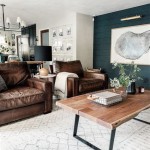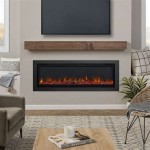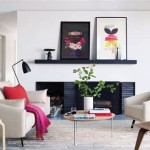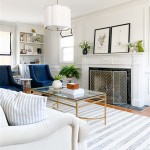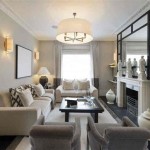Color Combinations For Living Room and Dining Room
The harmonious integration of color palettes between a living room and dining room can significantly enhance the overall aesthetic appeal and create a cohesive living space. Careful color selection can influence the mood, perceived size, and style within these areas, fostering an inviting and comfortable environment. Effective color combinations require consideration of the existing architectural features, natural lighting, and personal preferences of the occupants. A well-planned color scheme should not only be visually pleasing but also functional, supporting the intended use of each room.
The selection process often begins with identifying a dominant color that serves as the foundation for the entire scheme. This dominant color can be derived from existing furniture, artwork, or even a favorite accent piece. Subsequently, complementary and accent colors are chosen to create contrast, depth, and visual interest. The interplay between these colors can define the character of the space, ranging from serene and calming to vibrant and energetic.
Different color theories provide frameworks for effective color selection. Complementary color schemes, which utilize colors opposite each other on the color wheel, offer high contrast and visual excitement. Analogous color schemes, incorporating colors adjacent to each other, create a more harmonious and soothing effect. Triadic color schemes, using three colors equally spaced on the color wheel, offer a balanced and vibrant aesthetic. The choice of color scheme depends on the desired mood and the overall style of the interior design.
Understanding The Psychology of Color
Color psychology plays a crucial role in selecting appropriate color combinations for living and dining areas. Different colors evoke different emotional responses, and understanding these associations can help create the desired atmosphere within each room. For instance, blues and greens are often associated with tranquility and relaxation, making them suitable for creating a calming living room environment. Warm colors like reds, oranges, and yellows can stimulate appetite and conversation, making them ideal for dining rooms.
Neutrals, such as whites, grays, and beiges, are versatile and can be used as a backdrop to showcase other colors. They provide a sense of spaciousness and can be particularly effective in smaller living rooms and dining rooms. However, relying solely on neutrals can result in a sterile or bland environment. Therefore, incorporating pops of color through accessories, artwork, or accent walls is essential to add personality and visual interest.
The intensity and saturation of colors also influence their psychological impact. Soft, muted tones tend to create a more relaxed and understated atmosphere, while bright, saturated colors can invigorate and energize a space. The choice between muted and vibrant colors should be guided by the intended use of each room and the preferences of the occupants.
Furthermore, cultural associations with color can also be relevant, particularly when designing spaces for individuals with specific cultural backgrounds. Certain colors may have symbolic meanings or evoke strong emotional responses in different cultures, and these factors should be taken into consideration to create a comfortable and welcoming environment.
Creating Cohesion Between Living and Dining Areas
When selecting color combinations for a living room and dining room that are adjacent or open to each other, it is essential to establish a visual connection while maintaining the distinct character of each space. One approach is to use a unifying color palette throughout both rooms, with variations in intensity and accent colors to differentiate the areas.
For example, a living room might feature a light, airy beige on the walls, complemented by soft blue accents in the upholstery and accessories. The adjacent dining room could then incorporate the same beige on the walls, but with a deeper, more saturated blue as an accent color in the dining chairs or artwork. This creates a sense of continuity while visually separating the two spaces.
Another technique is to use a complementary color scheme, with one color dominating in the living room and the other in the dining room. For instance, a living room with predominantly green walls and accents could be paired with a dining room featuring predominantly red accents. This creates a vibrant and dynamic contrast, while still maintaining a cohesive aesthetic through the use of complementary colors.
The use of transitional elements, such as rugs, curtains, and artwork, can also help bridge the gap between the two rooms. These elements can incorporate colors and patterns that are present in both spaces, creating a visual link and reinforcing the overall design scheme. The key is to create a harmonious balance between the two rooms, ensuring that they complement each other rather than competing for attention.
Consider the flow of natural light between the rooms. A darker dining room may benefit from lighter paint colors to maximize brightness, while a sun-drenched living room can handle richer, deeper shades without feeling overwhelming. The paint finish also matters. Matte finishes absorb light, which can make a room feel cozier. Semi-gloss reflects light, making spaces appear brighter and cleaner, which is beneficial in dining areas often used for entertaining.
Exploring Popular and Effective Color Combinations
Numerous color combinations can be successfully employed in living and dining rooms, each offering a unique aesthetic and atmosphere. The following are some popular and effective combinations to consider:
*
Gray and Yellow:
This combination offers a contemporary and sophisticated look. Gray provides a neutral backdrop, while yellow adds a pop of energy and warmth. The specific shades of gray and yellow can be adjusted to create different moods, from a calming and refined atmosphere to a vibrant and playful one.*
Blue and White:
This classic combination evokes a sense of tranquility and serenity. Blue, particularly lighter shades, can create a calming and airy feel, while white enhances the sense of spaciousness and cleanliness. This combination is particularly well-suited for coastal or nautical-themed interiors.*
Green and Brown:
This earthy combination brings a sense of nature and harmony into the home. Green, in its various shades, represents growth and renewal, while brown provides a grounding and stabilizing effect. This combination can be particularly effective in creating a relaxed and inviting atmosphere.*
Black and White:
This timeless combination offers a dramatic and sophisticated look. Black provides a sense of depth and contrast, while white enhances the brightness and clarity of the space. This combination can be particularly effective in creating a modern or minimalist aesthetic.*
Beige and Cream:
This neutral combination creates a warm and inviting atmosphere. Both colors are versatile and work well with a variety of design styles. Pops of color can be added through the use of accessories like cushions, artwork, and rugs.*
Teal and Gold:
This combination combines cool and warm tones for a luxurious feel. Teal provides depth and sophistication, while gold adds a touch of glamour and elegance. This color scheme works well in both modern and traditional settings.*
Lavender and Gray:
This pairing creates a calming and sophisticated atmosphere. Lavender, a soft and subtle purple, complements gray's neutrality, resulting in a serene and elegant space. It's especially fitting for a living room intended for relaxation.Ultimately, the best color combination for a living room and dining room depends on the individual preferences, lifestyle, and design goals of the occupants. It is crucial to experiment with different combinations, consider the existing architectural features and natural lighting, and create a space that is both visually appealing and functionally supportive.
Before committing to a specific color scheme, paint small sections of walls with different colors and observe how they look at various times of the day and under different lighting conditions. This helps ensure that the chosen colors are visually pleasing and create the desired atmosphere in both the living room and dining room.

A Guide To Dining Room Colour Combinations Design Cafe

Modern Living Room And Dining Decorating Color Schemes With Blue Wall Paint Colors

69 Best Living Room Paint Colors For 2025

90 Wall Colour Combination For 2024 Stunning Paint Colours Your Room

54 Simple Ideas For Small Living Room Dining Combo Edward George
:max_bytes(150000):strip_icc()/MaryPatton_May2020-6-8e9f410c0f1d4fe28484853ea47b1d5c.jpg?strip=all)
40 Perfect Dining Room Colors For Any Style

15 Dining Room Color Ideas For Your Home

The Biggest Room Color Trends According To Instagram Homes And Gardens

50 Best Living Room Paint Ideas Colors

2025 Color Collection Of The Year Hgtv Home By Sherwin Williams

